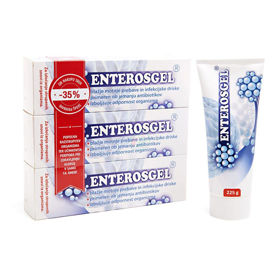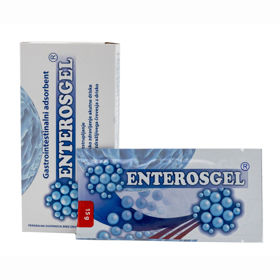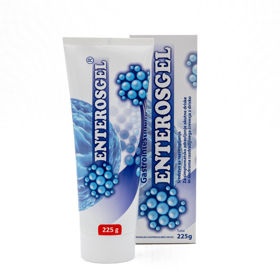Ulcerative colitis is a chronic disease in which the colon becomes inflamed and ulcerated, causing bouts of bloody diarrhea, abdominal cramps, and fever. Ulcerative colitis can start at any age but usually between the ages of 15 and 30. A small group of people have their first attack between the ages of 50 and 70.
ULCEROSIC COLITIS: General | Symptoms | Complications | Diagnosis | Treatment | Operation | Questions and Answers | Sources/references
Unlike Crohn's disease, ulcerative colitis usually does not affect the entire colon and never attacks the small intestine. The disease usually begins in the rectum or colon and sooner or later spreads wholly or partially throughout the colon.
In some patients, most of the large intestine is already affected in the early stages of the disease.
Image: The patient's symptoms and stool examination help establish the diagnosis.
.jpg)
About 10 percent of patients who appear to have ulcerative colitis have a single attack. However, some of these cases may be an undetected infection rather than true ulcerative colitis. The cause of ulcerative colitis is unknown, but heredity and overactive immune responses in the gut may be contributing factors.
Symptoms
The attack can be sudden and severe, with severe diarrhea, high fever, abdominal pain, and peritonitis (inflammation of the peritoneum). During such attacks, the patient is significantly affected. More often, the attack begins gradually. The patient is forced to defecate, has mild cramps in the lower abdomen, and has visible blood and mucus in the stool.
Video content: Health chapter: Ulcerative colitis.

When the disease is limited to the rectum and large intestine, the stool may be normal or hard and dry; however, during defecation or successive defecation, mucus, which contains many red and white blood cells, is discharged from the rectum. General disease symptoms, e.g., fever, are mild or absent.
If the disease spreads upwards to the higher parts of the large intestine, the stool is thinner, and the patient may defecate ten to twenty times a day. Often, the patient has severe abdominal cramps and excruciating, painful rectal spasms that accompany the need to defecate. There is no relief at night. Stools can be watery and contain pus, blood, and mucus. It often consists almost entirely of blood and pus. The patient may also have a fever and not run, worsening it.
Plots
Bleeding, the most common complication often causes iron deficiency anemia. In almost 10 percent of patients with ulcerative colitis, the rapidly progressing first attack becomes very severe, with heavy bleeding, perforation, or extensive infection.
In toxic colitis, a particularly severe complication, damage to the entire thickness of the intestinal wall occurs. The defect causes an ileus, a condition in which the contraction of the intestinal wall stops so that the intestinal contents are no longer pushed forward. The abdomen stretches. As toxic colitis worsens, the colon loses muscle tone and begins to stretch within a few days or even a few hours.
Image: Patients with the UK have a 6x higher risk of developing colorectal cancer.
.jpg)
Abdominal X-rays show gas in paralyzed sections of the bowel. The condition is called a toxic megacolon when the colon becomes severely distended. The patient is severely affected and may have a high fever. He also has abdominal pain and an elevated white blood cell count. The risk of colon cancer is higher in patients with long-standing, extensive ulcerative colitis. The risk of colon cancer is most significant when the entire colon is affected and the patient has had ulcerative colitis for more than ten years, regardless of disease activity.
In patients with a high risk of cancer, colonoscopy (examination of the colon with a flexible viewing tube) is recommended at regular intervals, if possible, during symptom-free periods. During a colonoscopy, tissue samples are taken from the entire colon for examination under a microscope. Cancer every time this occurs in 1 percent of patients with the disease. Most of them survive if the cancer is diagnosed in its early stage.
Like Crohn's disease, ulcerative colitis is associated with diseases affecting other body parts. When ulcerative colitis causes a flare-up of intestinal symptoms, the patient may also have inflammation of the joints (arthritis), inflammation of the sclera of the eye (episcleritis), inflamed skin nodules (erythema nodosum), and blue-red skin ulcers containing pus (pyoderma gangrenosum). When ulcerative colitis does not cause intestinal symptoms, the patient may still have inflammation of the spine (ankylosing spondylitis), inflammation of the pelvic joints (sacroiliitis), and inflammation of the eye (uveitis).
Video content: Life with ulcerative colitis.

Although ulcerative colitis patients often have mildly impaired liver function, only 1 to 3 percent develop symptoms of mild to severe liver disease. Severe disease can include inflammation of the liver (chronic active hepatitis), inflammation of the bile ducts (primary sclerosing cholangitis), which causes narrowing and sooner or later obstruction of the bile ducts, and replacement of functional liver tissue with connective tissue (cirrhosis). Inflammation of the bile ducts can appear several years before the first intestinal symptoms of ulcerative colitis and increases the risk of bile duct cancer.
Diagnosis
The patient's symptoms and stool examination help establish the diagnosis. Blood tests show anemia, increased concentrations of white blood cells, decreased albumin concentration, and accelerated sedimentation of red blood cells.
Sigmoidoscopy confirms the diagnosis and allows the doctor to observe the degree of inflammation directly. Even when the patient is symptom-free, the bowel rarely looks normal, and a tissue sample taken for examination under a microscope shows chronic inflammation.
An X-ray of the abdomen can show the stage and extent of the disease. X-rays with barium enema and colonoscopy are usually not done before the start of treatment because these tests, done during active periods of the disease, would pose a risk of perforation. Sooner or later, these tests usually examine the entire colon to determine the extent of the disease and to make sure there are no signs of cancer.
Image: An X-ray of the abdomen can show the stage and extent of the disease.
.jpg)
Inflammation of the colon has many other causes besides ulcerative colitis. In this way, the doctor determines whether an infection with bacteria or parasites causes the inflammation. Stool samples obtained during sigmoidoscopy are examined under a microscope and inoculated onto bacterial cultures. Blood samples are analyzed to determine whether the patient may have had some parasite infections on the trip, e.g.,
Tissue samples are taken from the rectal mucosa and examined under a microscope. The doctor also rules out sexually transmitted diseases of the rectum, e.g., infections with gonorrhea, herpes virus, or chlamydia, especially if the patient is a male homosexual. In older people with atherosclerosis, the inflammation can be caused by a reduced blood supply to the colon. Colon cancer rarely causes fever or discharge of pus from the rectum, but the doctor should consider cancer as a possible cause of bloody diarrhea.
Treatment
Treatment aims to control inflammation, reduce symptoms, and replace lost fluids and nutrients. The patient should avoid raw fruits and vegetables so as not to injure the inflamed lining of the large intestine physically. A dairy-free diet may alleviate symptoms and is worth a try. Iron preparations can reduce anemia caused by constant blood loss through the stool.
Patients take anticholinergic drugs or low doses of loperamide for relatively mild diarrhea. For more severe diarrhea, higher doses may be needed. In severe cases, the doctor closely monitors the patient who is taking these antidiarrheal drugs and the antidiarrheal formation of toxic megacolon.
Sulphasalazine or mesalazine is often used to reduce inflammation in ulcerative colitis and prevent flare-ups. Patients usually consume it, but it can also be used as an enema or suppository.
Patients with moderately severe disease who are not bedridden usually take corticosteroids, such as prednisone. Corticosteroids, in pretty large doses, often produce dramatic remission. After controlling the inflammation with them, patients are often given sulfasalazine or mesalazine.
Image: Sulfasalazine is often used to prevent flare-ups.
.jpg)
They gradually reduce the doses of prednisone and eventually stop it. Long-term corticosteroid treatment almost always causes unwanted side effects, although most of them disappear after the drug is stopped. When mild or moderate ulcerative colitis is limited to the left (downward) side of the colon and rectum, corticosteroid or mesalazine enemas are sometimes given.
If the disease worsens, the patient is admitted to the hospital and given intravenous corticosteroids. Patients with profuse rectal bleeding may require intravenous blood and fluid transfusions.
Azathioprine and mercaptopurine are used to maintain remissions in patients with ulcerative colitis who would otherwise require long-term corticosteroid therapy. Cyclosporine is given to some people who have had severe attacks and have not responded to corticosteroid therapy, but about half of these patients eventually need surgery.
Operation
Toxic colitis is an emergency. As soon as the doctor discovers or suspects impending toxic megacolon, all antidiarrheal medicaantidiarrhealontinued, the patient is given nothing more to eat; a tube is inserted through the nose into the stomach or small intestine and connected to intermittent suction (suction at intervals); all fluids, food, and medicines are given to the patient intravenously. The patient is closely monitored for signs of peritonitis or perforation. If these measures do not improve the patient's condition within 24 to 48 hours, emergency surgery is required, in which most or all of the colon is removed.
Elective surgery is performed when cancer is diagnosed, or precancerous changes are found in the colon. Such an operation can also be performed due to the narrowing of the large intestine or delayed growth in children. The most common reason for surgery is chronic disease without remissions, which would otherwise render the patient disabled or chronically dependent on high doses of corticosteroids. In rare cases, surgery may become necessary due to severe extra-intestinal problems associated with colitis, e.g., due to pyoderma gangrenosum.
Video content: Ulcerative colitis: fresh approaches to taming inflammation.

Complete removal of the colon and rectum permanently cures ulcerative colitis. From time immemorial, the price of such a cure has been life with a permanent ileostomy (operatively made connection between the lower end of the small intestine and an opening in the abdominal wall) and an ileostomy bag. However, various alternative procedures are available, the most common of which is ileoanal anastomosis. In this procedure, the large intestine and most of the rectum are removed, and the small intestine is made into a small reservoir attached to the remaining rectum just above the buttock. With this procedure, continence is preserved, although some complications may occur, e.g., inflammation of the tank.
Questions and answers
Does ulcerative colitis cause cancer?
Patients with ulcerative colitis have a 6x higher risk of developing colorectal cancer than those with an average risk. However, only about 5% of people with severe ulcerative colitis will eventually develop this type of cancer. Additionally, there are ways you can reduce your risk[1].
What is the most common cause of ulcerative colitis?
The exact cause of ulcerative colitis is unknown, but some things trigger it or make it worse. This may involve an abnormal immune response against certain microorganisms, which also attacks your tissues. Genetics can also play a role[2].
What are the risk factors for the development of ulcerative colitis?
Anyone can get ulcerative colitis, but your risk is higher based on:
- Age: most people are diagnosed between the ages of 15 and 30 or when they are over 60.
- Race and ethnicity: If you are Caucasian, you have a higher risk of UK, especially if you are of Ashkenazi Jewish descent.
- Genetics: you are more likely to get the UK if a first-generation relative has it.
- Gut microbiome: people with UC have differences in their microbiomes compared to people without UC[3]
Or, for ulcerative colitis, can children also get catfish?
Yes, children can also get sick. Ulcerative colitis is terrible for anyone, but it's tough on children, whose symptoms tend to be more severe. With proper treatment, children with ulcerative colitis can live happy and healthy lives[4].
How do we know we have ulcerative colitis?
Diarrhea and bloody stools are the two most common first symptoms of ulcerative colitis. People also often experience abdominal or rectal pain, weight loss, and fever[2].
Can ulcerative colitis appear suddenly?
Ulcerative colitis can start gradually and get worse over time. But it can also start suddenly. Symptoms can vary from mild to severe. Between periods of flares—times when people have symptoms—most people have periods of remission—times when symptoms disappear[5].
Is ulcerative colitis a chronic condition?
The UK is a chronic disease, which means there is no cure. However, it is common for people to go into remission, in which they spend years without symptoms[4].
Sources and references
Extensive health manual for home use, Youth Book Publishing House
- How Ulcerative Colitis Affects Your Risk for Developing Colorectal Cancer - https://www.compassoncology.com
- Ulcerative colitis - https://www.mayoclinic.org
- Ulcerative Colitis - https://my.clevelandclinic.org
- Pediatric Ulcerative Colitis - https://www.yalemedicine.org
- Definition & Facts of Ulcerative Colitis - https://www.niddk.nih.gov










 Facebook
Facebook
 Instagram
Instagram
 info@moja-lekarna.com
info@moja-lekarna.com

